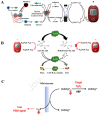Recent Developments in Personal Glucose Meters as Point-of-Care Testing Devices (2020-2024)
- PMID: 39329794
- PMCID: PMC11430212
- DOI: 10.3390/bios14090419
Recent Developments in Personal Glucose Meters as Point-of-Care Testing Devices (2020-2024)
Abstract
Point-of-care testing (POCT) is a contemporary diagnostic approach characterized by its user-friendly nature, cost efficiency, environmental compatibility, and lack of reliance on professional experts. Therefore, it is widely used in clinical diagnosis and other analytical testing fields to meet the demand for rapid and convenient testing. The application of POCT technology not only improves testing efficiency, but also brings convenience and benefits to the healthcare industry. The personal glucose meter (PGM) is a highly successful commercial POCT tool that has been widely used not only for glucose analysis, but also for non-glucose target detection. In this review, the recent advances from 2020 to 2024 in non-glucose target analysis for PGMs as POCT devices are summarized. The signal transduction strategies for non-glucose target analysis based on PGMs, including enzymatic transduction, nanocarrier transduction (enzyme or glucose), and glucose consumption transduction are briefly introduced. Meanwhile, the applications of PGMs in non-glucose target analysis are outlined, encompassing biomedical, environmental, and food analysis, along with other diverse applications. Finally, the prospects of and obstacles to employing PGMs as POCT tools for non-glucose target analysis are discussed.
Keywords: enzymatic transduction; glucose consumption transduction; nanocarrier transduction; non-glucose target; personal glucose meters.
Conflict of interest statement
The authors declare no conflicts of interest.
Figures









Similar articles
-
Integrating commercial personal glucose meter with peroxidase-mimic DNAzyme to develop a versatile point-of-care biosensing platform.Biosens Bioelectron. 2025 Apr 1;273:117171. doi: 10.1016/j.bios.2025.117171. Epub 2025 Jan 19. Biosens Bioelectron. 2025. PMID: 39837235
-
The application of personal glucose meters as universal point-of-care diagnostic tools.Biosens Bioelectron. 2020 Jan 15;148:111835. doi: 10.1016/j.bios.2019.111835. Epub 2019 Nov 2. Biosens Bioelectron. 2020. PMID: 31707326 Review.
-
Coupling CRISPR-Cas and a personal glucose meter with an enzymatic reporter for portable detection of human papillomavirus in biological samples.Theranostics. 2025 Feb 3;15(7):2870-2882. doi: 10.7150/thno.106490. eCollection 2025. Theranostics. 2025. PMID: 40083940 Free PMC article.
-
New sensing methods using commercially available products: Based on PGM and PTS.Biosens Bioelectron. 2025 Jan 1;267:116836. doi: 10.1016/j.bios.2024.116836. Epub 2024 Oct 4. Biosens Bioelectron. 2025. PMID: 39368295 Review.
-
The Personal Glucose Meter as the Measurement Principle in Point-of-Care Applications.Biosensors (Basel). 2025 Feb 19;15(2):121. doi: 10.3390/bios15020121. Biosensors (Basel). 2025. PMID: 39997023 Free PMC article. Review.
References
-
- Xu Z., Yu S., Mo W., Tang Y., Cheng Y., Ding L., Chen M., Peng S. Facile and Sensitive Method for Detecting Bisphenol A Using Ubiquitous pH Meters. ChemistrySelect. 2022;7:e202202002. doi: 10.1002/slct.202202002. - DOI
Publication types
MeSH terms
Substances
Grants and funding
- 2023MSXM006/Chongqing Medical Scientific Research Project (Joint project of Chongqing Health Commission and Science and Technology Bureau), China
- 2024QNXM015/Chongqing Medical Scientific Research Project (Joint project of Chongqing Health Commission and Science and Technology Bureau), China
- 2023SQKWLH037/Chongqing Shapingba Medical Scientific Research Project (Joint project of Chongqing Shapingba Health Commission and Science and Technology Bureau), China
- CSTB2022NSCQ-BHX0687/Postdoctoral Science Foundation of Chongqing, China
- ygzbhly2024101/Chongqing Medical and Pharmaceutical College, China
LinkOut - more resources
Full Text Sources

